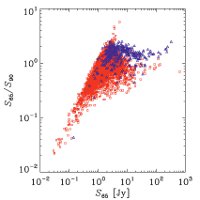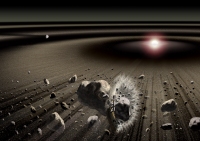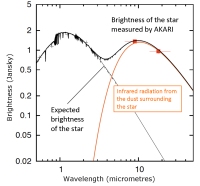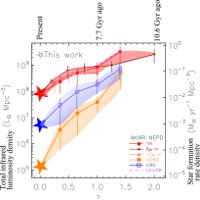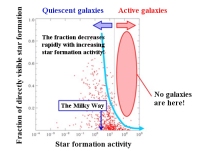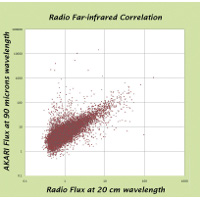Selected highlights from preliminary studies with the AKARI all-sky catalogues
Some preliminary scientific studies using these new AKARI catalogues have been carried out by AKARI team members. These touch on: studies of the star formation history in the Universe, properties of star-forming galaxies, and searches for evidence of dust associated with planet formation in the debris disks around stars other than the Sun. A selection of these studies is summarised below.
|
AKARI looks at the birth and growth of planets Many stars have been found to be surrounded by warm dust, which makes up their equivalent of the environment in our own Solar System. This warm dust is believed to be produced by the collisions and fragmentation of rocky bodies in the crowded environment left over after star formation. Embryonic young planets begin to form when small rocky bodies in this debris stick together, growing into larger bodies that are the embryonic precursors to planets. As the dust sensitively responds to the gravity of planets, its presence, distribution and properties can also be used to infer the presence of planets. The AKARI catalogues have been used to investigate in more detail the frequency of the planet formation process around many nearby stars, and to try to link these disks to the eventual family of planets that will grow.
| ||||
|
Cosmic star formation history measured by AKARI
Understanding cosmic star formation history is one of the major goals of modern astronomy. Observing star formation in the infrared is especially important, since much intense star formation activity is obscured by dust, and is only revealed in the infrared. However, the starting point of this history, the local star formation rate at the current epoch, is still based on the IRAS data, which covered 20 to 100 micrometres. Taking advantage of AKARI's six-band all-sky survey - which includes the key far-infrared wavelengths across the peak of the cool dust emission region up to 160 micrometres – it is possible to measure the local star formation density more precisely than before. By comparing this to results from the distant Universe (also measured by the AKARI deep survey, Wada et al., 2008) a cosmic star formation history can be deduced. This shows a steep increase from the current epoch back to 10.6 thousand million years ago, when the star formation density was 20 times higher. |
|
AKARI reveals hidden star formation activity in the present-day Universe
Before the planets and the material that is needed for the emergence of life are formed, the presence of oxygen, carbon, iron, and other heavy elements is needed, even though these heavy elements represent only a small fraction of the total matter in the Universe. Such elements are only produced in the centres of stars. By studying the history of star formation in galaxies it is possible to predict the amount of heavy elements in the Universe that is available to form other stars, planets, and even life itself. The AKARI Far-Infrared All-Sky Survey has been used with other surveys at ultraviolet, optical, and near-infrared wavelengths, to investigate the star formation activity in galaxies in the present-day Universe. These studies clearly demonstrate that most of the star formation activity is invisible at optical wavelengths because the bulk of the material in galaxies is almost completely obscured by dust. The AKARI catalogues have been used to search samples of galaxies to reveal the incidence and properties of their star-forming activity. |
|
AKARI searches for unusual objects The AKARI catalogues provide unique resources within which to search for rare objects, or sources showing extreme properties. Active galactic nuclei (AGN) are among the most powerful objects in the Universe, releasing an extraordinary amount of energy from their unresolved nuclei. Active supermassive black holes (SMBH) in the centre of these galaxies are responsible for the tremendous diversity in their observed energy emission. These are normally identified by comparing the fluxes of objects with other tracers, such as radio emission or stellar populations of galaxies. In the example shown here the radio emission traces the star formation in galaxies, with rare objects that are either radio bright (indicating energetic processes such as an active black hole), or radio weak (indicating little star formation) deviating from the main clustering of sources.
|

